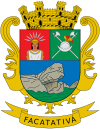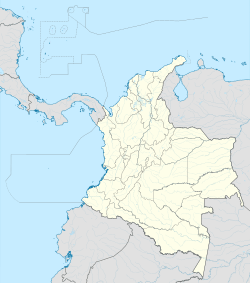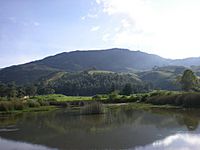Facatativá facts for kids
Quick facts for kids
Facatativá
|
|||
|---|---|---|---|
|
Municipality and city
|
|||

Cathedral of Facatativá
|
|||
|
|||
| Motto(s):
Present and future of Cundinamarca
(Presente y futuro de Cundinamarca) |
|||

Geolocation of Facatativá in Cundinamarca
|
|||
| Country | |||
| Department | |||
| Province | Western Savanna Province | ||
| Founded | July 3, 1600 | ||
| Founded by | Diego Gómez de Mena | ||
| Area | |||
| • Municipality and city | 158 km2 (61 sq mi) | ||
| • Urban | 7.65 km2 (2.95 sq mi) | ||
| Elevation | 2,586 m (8,484 ft) | ||
| Population
(2020 est.)
|
|||
| • Municipality and city | 155,978 | ||
| • Density | 987.2/km2 (2,557/sq mi) | ||
| • Urban | 145,080 | ||
| • Urban density | 18,965/km2 (49,120/sq mi) | ||
| Time zone | UTC-5 (Colombia Standard Time) | ||
| Area code(s) | +1 | ||
| Website | Official website: http://www.facatativa-cundinamarca.gov.co/ | ||
Facatativá is a city and municipality in the Cundinamarca Department of Colombia. It is located about 31 kilometers (18 miles) northwest of Bogotá. The city sits high up, at 2,586 meters (8,484 feet) above sea level.
Facatativá is famous for its Archaeological Park Piedras del Tunjo. This park is known for its large rock formations. These rocks were once at the bottom of an ancient lake. People often call it Piedras del Tunjo, which means "Rocks of the Tunjo Indian".
Contents
What Does the Name Facatativá Mean?
The name Facatativá comes from the ancient Chibcha language. This language was spoken by the Muisca who lived here long ago. The most common meaning for Facatativá is "fenced fort at the end of the plains". This name makes sense because the town is at the edge of the Bogotá savanna.
A Look at Facatativá's History
The history of Facatativá goes back to ancient times. People have lived in the highlands of Colombia since the Holocene era. This means humans have been here for thousands of years.
Early Inhabitants and Ancient Art
Many signs of early human life have been found in Facatativá. These include pottery from the Herrera Period and Muisca pottery. There are also ancient paintings and sculptures. These artworks show us about the beliefs and social life of these early people. The Piedras del Tunjo Archaeological Park has many prehistoric paintings.
The Arrival of the Spanish
Spanish explorers, led by Gonzalo Jiménez de Quesada, found Facatativá. They were searching for a legendary golden city called El Dorado. Jiménez de Quesada met the Muisca people here. He captured and killed their leader, zipa Tisquesusa, on July 15, 1537.
Facatativá was officially founded in 1600. This was done by a Spanish administrator named Diego Gómez de Mena. Like many Spanish towns, the church was the most important building. Gómez de Mena ordered the first church to be built in 1601.
The Famous Cathedral of Facatativá
The most important building in Facatativá is its cathedral. It is right next to the main square, Simon Bolivar Plaza.
Over the years, several earthquakes damaged the church. Each time, a new and stronger church was built.
- The first church was built in 1601. It was damaged by an earthquake in 1785.
- A new church was built in 1787. It became an Augustinian temple.
- Another earthquake in 1827 damaged this church.
- A new temple opened in 1870, and then a grander one in 1895.
- On February 9, 1967, a new earthquake hit. Bishop Monsignor Raul Zambrano Camader ordered a new, strong cathedral. This is the beautiful cathedral you see today. It is a popular place for worship and a tourist attraction.
Important Moments in Facatativá's Past
Much of Facatativá's history is found in old church books. Priests recorded important events in these books. The oldest book dates back to 1692.
18th Century Events
- On May 21, 1781, Captain José Antonio Galán and Lieutenant Nicolas Jose de Vesga arrived. They led a group of one hundred "comuneros" (common people). They were part of the Comuneros Revolt against Spanish rule.
19th Century Developments
- In the mid-1800s, a road was built from Los Manzanos to Bogotá. This was important for trade and travel.
- On March 9, 1848, Facatativá became the capital of the Canton of Funza. This was because of its good location.
- The first notary office opened in 1851.
- In 1865, the telegraph service started in Facatativá. This allowed people to send messages quickly.
- The City Hall was built in 1882.
- The Savanah railroad (Ferrocarril de la Sabana) began construction in 1882. It was finally built in 1886.
- On January 5, 1884, the first stone for a new hospital was laid.
20th Century Milestones
- On March 8, 1907, the district prison was built.
- On February 13, 1909, the first locomotive arrived from Girardot.
- On July 20, 1911, an obelisk was built in Santander Park. It honors heroes who died there in 1816.
- In 1933, the first Produce Market Plaza opened. It was one of the first in Colombia.
- On May 6, 1940, a bust of General Francisco de Paula Santander was placed in Santander Plaza. This honored 100 years since his death.
- On December 18, 1972, Monsignor Raul Zambrano Camader died in a plane crash. He was the first Bishop of Facatativá.
- The House of Culture was created on October 12, 1966. It provides courses and has a gallery for artists.
- In 1996, some riots happened. People protested a new bill about taxes. The bill was later changed.
Facatativá's Economy
Facatativá's main way of making money is agriculture. Because it is so high up, it is a great place to grow flowers. The Floral industry is very important here. It gives jobs to many people. More jobs are available around Saint Valentine's Day. This is because the United States buys many flowers from Colombia.
Many well-known companies also have facilities in Facatativá. These include the dairy company Alpina and the cosmetics company Yanbal. There is also the Colombian oil company Ecopetrol.
People in Facatativá can shop at several large department stores. These include Colombian-owned Exito and Chilean Jumbo.
Who Lives in Facatativá?
The people of Facatativá are mostly a mix of Spanish and Amerindian (indigenous) heritage. This mix is called "mestizo" and is the most common group. About 15% of the population are unmixed white people.
How Facatativá Stays Connected
For a long time, the Colombian company Telecom managed all telecommunications in Facatativá. Now, there are more companies offering services. This means better prices for internet and phone services.
Most people in Facatativá can get landline telephone lines. Also, cellular telephony is very popular in Colombia. This makes it easy for people to stay in touch.
If people do not have internet at home, they can go to internet cafes. Many schools are also working to get better internet access for students.
Facatativá has two important centers for wireless and radio communications. Colombia's biggest repeater antenna is on top of the Manjui Hill. This facility is very important for the country's communications.
Military Presence
Facatativá has several military and police groups. These include a communications battalion, police, and anti-narcotics squads. There is also a cavalry school and major police headquarters. They help protect the Colombian petroleum research facilities in the area.
Climate in Facatativá
| Climate data for Facatativá/Bojacá (Acapulco), elevation 2,650 m (8,690 ft), (1981–2010) | |||||||||||||
|---|---|---|---|---|---|---|---|---|---|---|---|---|---|
| Month | Jan | Feb | Mar | Apr | May | Jun | Jul | Aug | Sep | Oct | Nov | Dec | Year |
| Mean daily maximum °C (°F) | 16.1 (61.0) |
16.1 (61.0) |
16.0 (60.8) |
16.0 (60.8) |
16.1 (61.0) |
16.1 (61.0) |
15.7 (60.3) |
15.8 (60.4) |
16.3 (61.3) |
16.0 (60.8) |
16.0 (60.8) |
15.9 (60.6) |
16.0 (60.8) |
| Daily mean °C (°F) | 13.0 (55.4) |
13.2 (55.8) |
13.2 (55.8) |
13.4 (56.1) |
13.4 (56.1) |
13.1 (55.6) |
12.7 (54.9) |
12.9 (55.2) |
13.0 (55.4) |
13.1 (55.6) |
13.1 (55.6) |
12.9 (55.2) |
13.1 (55.6) |
| Mean daily minimum °C (°F) | 9.5 (49.1) |
9.3 (48.7) |
9.8 (49.6) |
10.1 (50.2) |
10.2 (50.4) |
9.9 (49.8) |
9.3 (48.7) |
9.4 (48.9) |
9.7 (49.5) |
9.7 (49.5) |
9.9 (49.8) |
9.5 (49.1) |
9.7 (49.5) |
| Average precipitation mm (inches) | 43.4 (1.71) |
54.8 (2.16) |
77.4 (3.05) |
111.9 (4.41) |
87.8 (3.46) |
44.5 (1.75) |
38.4 (1.51) |
35.1 (1.38) |
63.1 (2.48) |
105.3 (4.15) |
91.3 (3.59) |
70.9 (2.79) |
778.2 (30.64) |
| Average precipitation days | 7 | 7 | 11 | 13 | 12 | 10 | 10 | 9 | 10 | 13 | 12 | 9 | 115 |
| Average relative humidity (%) | 90 | 90 | 91 | 93 | 92 | 92 | 91 | 91 | 91 | 91 | 92 | 91 | 91 |
| Source: Instituto de Hidrologia Meteorologia y Estudios Ambientales | |||||||||||||
Images for kids
See also
 In Spanish: Facatativá para niños
In Spanish: Facatativá para niños










